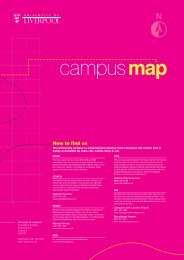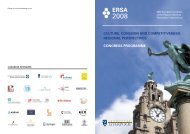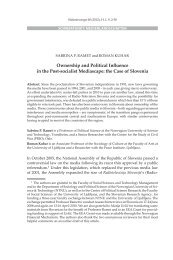The Scientific and Humane Legacy of Max Perutz - Molecular ...
The Scientific and Humane Legacy of Max Perutz - Molecular ...
The Scientific and Humane Legacy of Max Perutz - Molecular ...
Create successful ePaper yourself
Turn your PDF publications into a flip-book with our unique Google optimized e-Paper software.
ESSAY<br />
ramifying fields <strong>of</strong> present day molecular biology. In communicating<br />
knowledge to other scientists <strong>and</strong> the general<br />
public–<strong>and</strong> as an ambassador for science, its methods <strong>and</strong><br />
philosophy–few <strong>of</strong> his contemporaries rivaled him. So<br />
central were his interests in the vast corpus <strong>of</strong> scientific<br />
endeavor that he was regularly called upon to address<br />
biochemists, physicists, physiologists, pathologists, geneticists,<br />
<strong>and</strong> medical scientists <strong>of</strong> several other kinds. For the last<br />
forty years <strong>of</strong> his life he maintained a punishing round <strong>of</strong><br />
lecture commitments: one week it was to school sixth formers<br />
or to a University <strong>of</strong> the Third Age [8] audience; another it<br />
might be to the assembled researchers at places such as<br />
Rockefeller University, New York; the next to frontier<br />
scientists in the California Institute <strong>of</strong> Technology–or in<br />
Rome (lecturing in Italian), Berlin (in German, Figure 2), or<br />
Paris (in French).<br />
Figure 1. <strong>Max</strong> <strong>Perutz</strong> (right) constructing a model <strong>of</strong> the first ever protein<br />
structure determined by X-ray crystallography, with John Kendrew looking<br />
on (1959).<br />
detached character than <strong>Perutz</strong>. <strong>Perutz</strong> was a gentle, kindly,<br />
<strong>and</strong> tolerant lover <strong>of</strong> people (particularly the young),<br />
passionately committed to social justice <strong>and</strong> intellectual<br />
honesty; the warmth <strong>of</strong> his personality radiated a sense <strong>of</strong><br />
human goodness <strong>and</strong> decency which induced others to behave<br />
sanely, especially because he exuded an inner excitement that<br />
stems from a love <strong>of</strong> knowledge for its own sake. A<br />
distinguished American molecular biologist who worked in<br />
the <strong>Perutz</strong> ± Kendrew team as Kendrew×s postdoctoral assistant<br />
(1957 ± 1958), in a reflective article published in Protein<br />
Science, [7] wrote:<br />
<strong>Max</strong> <strong>and</strong> John were utterly different in personality.<br />
Kendrew came in two or three mornings a week to discuss<br />
the progress <strong>of</strong> the research, <strong>and</strong> to give help where help was<br />
needed. He was a great mentor for someone who wanted to<br />
learn how to be an independent investigator. At other times<br />
he was busy as a science advisor to the British government<br />
(on the Polaris missile system as I recall), as an administrator<br />
<strong>of</strong> Peterhouse (college), <strong>and</strong> on other affairs. In<br />
contrast, <strong>Max</strong> was never so happy as when in the laboratory<br />
at the bench, doing science. One learned by talking with<br />
John, but by watching <strong>Max</strong>∫.<br />
<strong>Perutz</strong>×s inspirational scientific leadership, more than that<br />
<strong>of</strong> any other, made it possible to unite structural crystallography<br />
<strong>and</strong> molecular pathology <strong>and</strong> helped to unfold the vast<br />
Figure 2. <strong>Max</strong> <strong>Perutz</strong> lecturing in Berlin, 1999. An enlarged photo <strong>of</strong><br />
Sage∫ (J. D. Bernal) is seen on the screen behind him.<br />
<strong>The</strong> Road to Haemoglobin<br />
<strong>Perutz</strong>, on Bernal×s advice, first learned <strong>of</strong> X-ray crystalstructure<br />
analysis in the Department <strong>of</strong> Mineralogy <strong>and</strong><br />
Petrology, Cambridge, where he was h<strong>and</strong>ed–as he later put<br />
it–a nasty crystalline flake <strong>of</strong> a silicate mineral picked <strong>of</strong>f a<br />
slag heap∫ to investigate. [9] This training proved crucial, for he<br />
became adept at X-ray crystallography <strong>and</strong> he set out to<br />
pursue his great problem in biochemistry∫. Guided a little<br />
later by a cousin, who lived in Prague, he soon convinced<br />
himself that an appropriate target for his ambitions was the<br />
structure <strong>of</strong> haemoglobin, especially since it was the protein<br />
that was most abundant <strong>and</strong> easiest to crystallize. It was not<br />
until the late 1950s that he finally reached his target <strong>of</strong><br />
elucidating the structure <strong>of</strong> haemoglobin; when he did, it<br />
made him famous. But his path to success was frequently<br />
thwarted by scientific, personal, <strong>and</strong> political obstacles.<br />
<strong>Perutz</strong> had obtained tantalizing X-ray diffraction patterns,<br />
published in 1938–just as Dorothy Crowfoot (later Hodgkin)<br />
<strong>and</strong> Bernal had earlier with crystals <strong>of</strong> the enzyme pepsin–<br />
<strong>and</strong> it could then be seen that the thous<strong>and</strong>s <strong>of</strong> reflections he<br />
had obtained could, in principle, lead to the atomically<br />
resolved structure <strong>of</strong> haemoglobin. Unfortunately there was<br />
3156 ¹ 2002 WILEY-VCH Verlag GmbH & Co. KGaA, Weinheim 1433-7851/02/4117-3156 $ 20.00+.50/0 Angew. Chem. Int. Ed. 2002, 41, No.17





